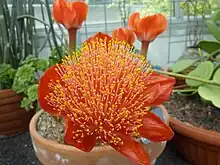| Haemanthinae | |
|---|---|
 | |
| Haemanthus coccineus | |
| Scientific classification | |
| Kingdom: | Plantae |
| Clade: | Tracheophytes |
| Clade: | Angiosperms |
| Clade: | Monocots |
| Order: | Asparagales |
| Family: | Amaryllidaceae |
| Subfamily: | Amaryllidoideae |
| Tribe: | Haemantheae |
| Subtribe: | Haemanthinae Pax[1] or Baker[2] |
| Type genus | |
| Haemanthus | |
| Genera | |
| Synonyms[1] | |
|
Haemanthineae (orth. var.) | |
Haemanthinae is a small subtribe of Haemantheae, and therefore within the African clades of Amaryllidoideae. It consists of two genera, Haemanthus, and Scadoxus.
Description
The genera of Haemanthinae share brush-like inflorescences, in which the bracts frequently form part of the pollinator attraction system. Not all Scadoxus form bulbs, while all species of Haemanthus do.[1]
Taxonomy
For the early taxonomic history of these two genera, see Meerow and Clayton (2004).[1] Pax (1888) treated the Amaryllidaceae as four subfamilies, with two tribes in subfamily Amarylloideae, which consisted of two tribes, Amaryllideae and Narcisseae. The former contained six subtribes, placing Haemanthus together with Clivia in subtribe Haemanthinae.[3] Hutchinson (1934) subsequently elevated this to tribe Haemantheae.[4] Later, Traub placed Haemanthus with Choananthus (subsequently submerged in Scadoxus) in tribe Haemantheae in his 1963 monograph on the Amaryllidaceae.[5] Later the Müller-Doblies' created a narrower concept of Haemantheae as a tribe with Haemanthinae as one of two subtribes and two genera, Haemanthus and Scadoxus.[6] Molecular phylogenetic research has confirmed this placement, with Meerow and Clayton (2004) situating Haemanthinae[note 1] as one of three subtribes of Haemantheae.[1]
Phylogeny
The Haemanthinae are placed within the Haemantheae as follows:
| Tribe Haemantheae |
| ||||||||||||
Subdivision
- Haemanthus (21 species)
- Scadoxus (9–12 species)
Distribution and habitat
Scadoxus is a forest understory herbaceous genus, most commonly found in the tropical areas of Africa. Haemanthus on the other hand is confined to southern Africa, within the summer and winter rainfall regions of the Cape.[1]
Notes
- ↑ They used the spelling "Haemanthineae" in this paper, which differs from earlier authors and is contrary to Article 19 of the International Code of Nomenclature for algae, fungi, and plants, which requires subtribe names to have the ending "-inae".[7]
References
Bibliography
- Hutchinson, John (1934). The families of flowering plants, arranged according to a new system based on their probable phylogeny. 2 vols (1 ed.). Macmillan. Volume 1: Monocotyledonae 1926, Volume 2:Dicotyledonae 1934.
- Meerow, Alan W.; Clayton, Jason R. (1 February 2004). "Generic relationships among the baccate-fruited Amaryllidaceae (tribe Haemantheae) inferred from plastid and nuclear non-coding DNA sequences". Plant Systematics and Evolution. 244 (3–4): 141–155. doi:10.1007/s00606-003-0085-z. S2CID 10245220.
- Meerow, Alan W.; Snijman, Deirdre A. (2006). "The never-ending story: multigene approaches to the phylogeny of Amaryllidaceae". Aliso. 22: 355–366. doi:10.5642/aliso.20062201.29. Retrieved 25 January 2015.
- Reveal, James L. (2012). "Indices Nominum Supragenericorum Plantarum Vascularium – H". Retrieved 8 March 2016.
- Vigneron, Pascal. "Amaryllidaceae". Amaryllidaceae.org (in French). Archived from the original on 4 January 2015. Retrieved 23 October 2014.
- "Amaryllidaceae: A taxonomic tool for the Amaryllidaceae of the world". eMonocot. Archived from the original on 4 March 2016. Retrieved 7 March 2016.
- Traub, H.P. (1963). Genera of the Amaryllidaceae. Genera of organisms. La Jolla, California: American Plant Life Society.
- Müller-Doblies, U.; Müller-Doblies, D. (1996). "Tribes and subtribes and some species combinations in Amaryllidaceae J St Hil R Dahlgren & al. 1985". Feddes Repertorium. 107 (5–6): S.c.1–S.c.9.
- Pax, Ferdinand. Amaryllidaceae. pp. 97–124., in Engler & Prantl (1888)
- Engler, Adolf; Prantl, Karl, eds. (1888). Die Natürlichen Pflanzenfamilien nebst ihren Gattungen und wichtigeren Arten, insbesondere den Nutzpflanzen, unter Mitwirkung zahlreicher hervorragender Fachgelehrten 1887–1915 II(5) (in German). Leipzig: W. Engelmann. Retrieved 6 April 2015.
- McNeill, J.; et al., eds. (2012). "Article 19". International Code of Nomenclature for algae, fungi, and plants (Melbourne Code), Adopted by the Eighteenth International Botanical Congress Melbourne, Australia, July 2011 (electronic ed.). Bratislava: International Association for Plant Taxonomy. Retrieved 9 March 2016.
